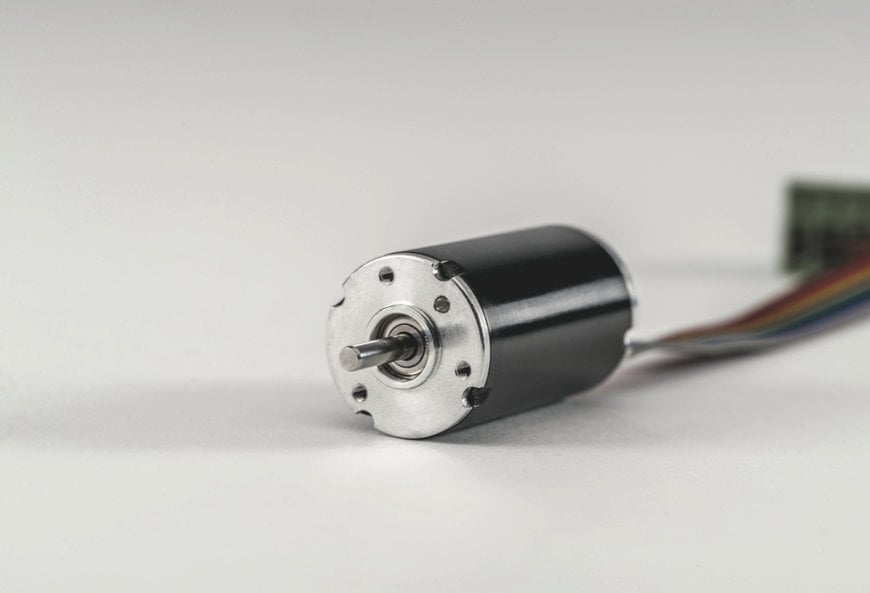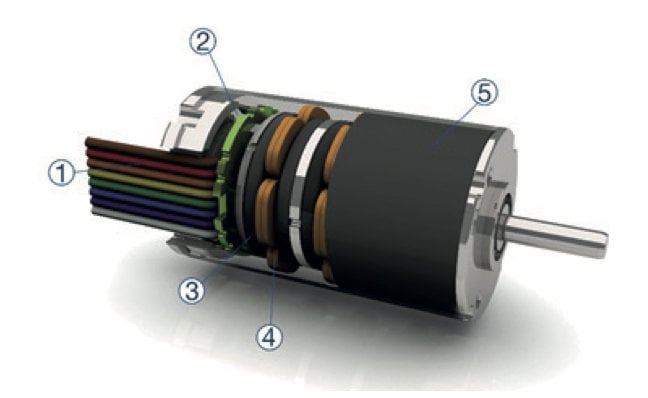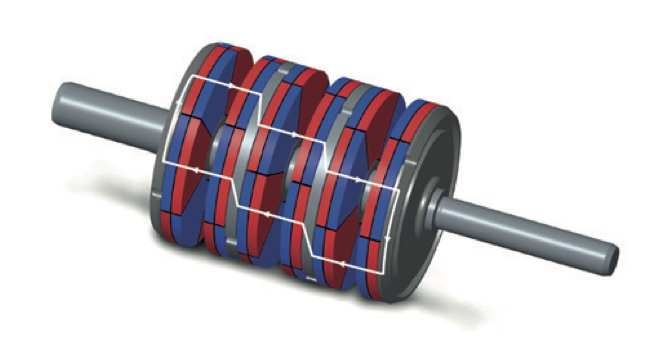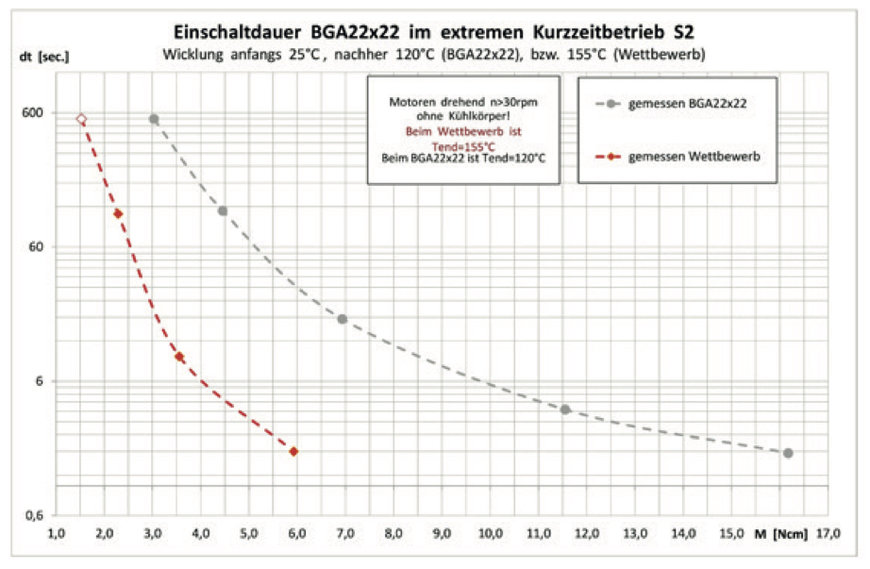www.industry-asia-pacific.com
08
'20
Written on Modified on
BLDC motor with axial flux principle convinces in small space
By Stefan Tröndle, Product Manager DC Motors & Gearboxes Dunkermotoren GmbH

You do not hear it, you hardly see it, even when touched you can only divine it. What is it? A question that is answered different to fairy tales with a real product for drive technology - the ironless DC motor BGA 22, which is constructed according to the axial flux principle. Searched and found for a motor that combines the demand for high torque with small cons- truction diameter, quiet running and low self-heating in the labors of Dunkermotoren. The BGA 22 is strong, quiet and hardly heats up even under total load.
The operating principle
In the case of the axial flux motor, the magnetic fields are formed in the axial direction, this means parallel to the motor shaft, while in conventionally built motors, the magnetic field is formed radially. The motor is ironless, cogging and resetting losses are thereby eliminated or heavily reduced. This basic principle is already known from the so-called „Printed Motors“, which are used, inter alia, in consumer electronics. However, in Dunkermotoren several combinations of winding and perma- nent magnets are stacked one behind the other. The structure is shown in image 1.

1. Cable
2. Hall-PCB
3. Magnet plate
4. Winding plate
5. Housing
The following plates occur in turns: Pos. 4 - the plate carries the winding for a motor phase and is connected to the housing and Pos. 3 - the plate consists of magnets which are mounted on a steel plate and rotate with the motor shaft. The magnets thus transmit the torque to the shaft and rotate with it. These steel plates form a solid fixation of the magnets on the shaft and allow the rotation of the magnets whereby a rotation of the 3 winding plates with each other (to form the 3 motor pha- ses) is no longer necessary, whereby the engine structure is significantly simplified. The magnetic flux is shown in image 2.

Because the motor is constructed in 3 phases, at least three such stacks are needed to get a func- tional motor. The number of packages with three stacks makes it possible, with a corresponding increase in the overall length, to increase the performance of the motor while maintaining the same construction diameter.
What gives the BGA 22 its power?
Because of the axial flux principle, the housing of the BGA 22 has only the purely mechanical task to keep the motor in its shape. Therefore, the housing itself can be constructed very thin-walled. This allows the magnetic plate to be provided with a larger diameter. Ironless motors of different types need an inference at the external diameter consisting of ferromagnetic material for the radial flux. This reduces the external diameter on which the motor torque is built up. Since the magnetic forces act on a larger diameter in the axial flow principle, a large torque can be generated with re- latively little magnetic material. This ensures material savings in terms of sustainable construction and thus reduces dependence on raw material suppliers for neodymium and dysprosium. If you are looking for a high-power density, you can choose a type that turns up the motor speed from the existing portfolio and with the appropriate planetary gearbox reduced to the desired speed again. The efficiency afforded to the BGA 22 by the axial flux principle ensures high overload capability in short-time operation. As seen in the nomogram image 3, the motor heats up more slowly than conventionally constructed ironless motors of the same size and shape.

The practical benefits get visible when it comes to moving high loads at longer intervals. As an example, the lifting and opening of a glazed and thus heavy balcony door from the locking. The motor, which is integrated in the door frame and thus limited to the diameter of 22 mm, is thus loaded with 3 times nominal torque, i. e. approximately 6 Ncm. If one assumes a starting tempera- ture of 25°C, the conventionally built motor reaches the limit temperature of 155°C after less than two seconds in its winding while the BGA 22 reaches the limit temperature of only 120°C after 30 seconds. The BGA 22 can thus provide 15 times as long as 3 times the rated torque and does not reach the limit temperature of the comparable motor of 155°C.
What makes the smoothness of the BGA 22 possible?
There are no brushes in the structure of the motor because the BGA 22 belongs to the BLDC mo- tors. Missing cogging forces and an also the missing resetting, enable together with the brushless structure an extremely high level of smoothness. Only the ball bearings and the commutation are noticeable during operation, if only slightly. When integrated into a device, it is difficult for the user to assess whether the motor is in operation or not. Theoretically, the BGA 22 has no imbalance. In the field, a small imbalance arises due to manufacturing tolerances. This can be tolerated in some applications, but usually the rotor is fine balanced on specially developed machines. Thus, the motor is low in vibration and gives to its environment e.g. to the housing, which surrounds him, virtually no vibrations. The device remains calm and shows in variation of the speed already with simple block commutation no resonance phenomena. In this size, the rarely encountered vector commutation improves the behavior in addition.
Why is not the BGA 22 warming up as much as comparable engines of its size?
Unlike other ironless motors of the same size, the BGA 22 has a high power density at relatively low winding temperatures. Manufacturers, who prefer the construction of the self-supporting winding, go along with the temperature class F (155°C). Dunkermotoren could limit this to class E, which corresponds to a temperature of 120°C. This is possible because of the good heat dissipation. The windings, which are the hottest point in the motor, are connected directly to the housing in a heat conductive way. Thus, there is no heat flow-insulating air gap between the winding and the environment. The heat is dissipated optimally. A less hot operated motor allows an extended ser- vice life of the ball bearings and provides multiple benefits in the application. Attachments such as gearboxes and encoders, which are available from the Dunkermotoren modular system, are loaded less, which allows a longer service life. Other materials that are used here are not exposed to such a high temperature and can therefore be optimized from another point of view e. g. the acquisition costs. Devices which have a BGA 22 integrated, will remain cooler during operation, providing the user with a pleasant feel in case of direct contact with the motor. The target of Dunkermotoren is to extend this motor to a sterilizable version. Its low level of warming will then be appreciated at a touch with cell tissue and will be preferred for use in temperature-sensitive applications.
Conclusion:
The BGA 22 is a brushless, ironless motor on the market which can be exposed to large loads, convinced with a quiet running and less heated than previously known motors with comparable di- mensions. With the available winding variance and the modular construction kit, it can be designed and configured for almost any application
www.dunkermotoren.com

